
Question Number 1231 by Rasheed Soomro last updated on 16/Jul/15
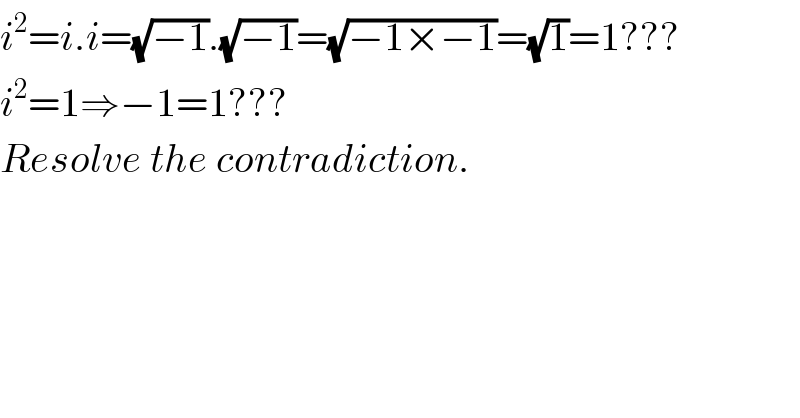
$${i}^{\mathrm{2}} ={i}.{i}=\sqrt{−\mathrm{1}}.\sqrt{−\mathrm{1}}=\sqrt{−\mathrm{1}×−\mathrm{1}}=\sqrt{\mathrm{1}}=\mathrm{1}??? \\ $$$${i}^{\mathrm{2}} =\mathrm{1}\Rightarrow−\mathrm{1}=\mathrm{1}???\: \\ $$$${Resolve}\:{the}\:{contradiction}. \\ $$
Commented by prakash jain last updated on 17/Jul/15
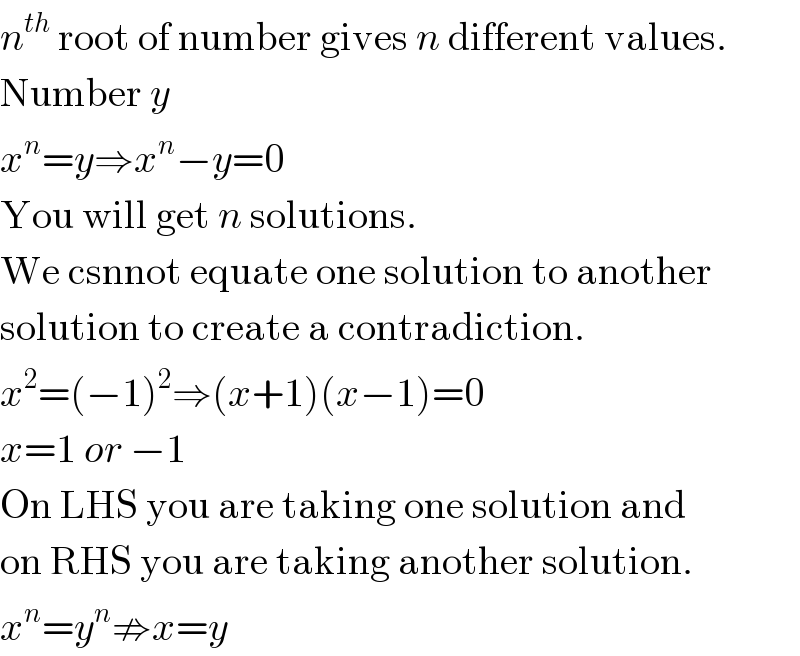
$${n}^{{th}} \:\mathrm{root}\:\mathrm{of}\:\mathrm{number}\:\mathrm{gives}\:{n}\:\mathrm{different}\:\mathrm{values}. \\ $$$$\mathrm{Number}\:{y} \\ $$$${x}^{{n}} ={y}\Rightarrow{x}^{{n}} −{y}=\mathrm{0} \\ $$$$\mathrm{You}\:\mathrm{will}\:\mathrm{get}\:{n}\:\mathrm{solutions}. \\ $$$$\mathrm{We}\:\mathrm{csnnot}\:\mathrm{equate}\:\mathrm{one}\:\mathrm{solution}\:\mathrm{to}\:\mathrm{another} \\ $$$$\mathrm{solution}\:\mathrm{to}\:\mathrm{create}\:\mathrm{a}\:\mathrm{contradiction}. \\ $$$${x}^{\mathrm{2}} =\left(−\mathrm{1}\right)^{\mathrm{2}} \Rightarrow\left({x}+\mathrm{1}\right)\left({x}−\mathrm{1}\right)=\mathrm{0} \\ $$$${x}=\mathrm{1}\:{or}\:−\mathrm{1} \\ $$$$\mathrm{On}\:\mathrm{LHS}\:\mathrm{you}\:\mathrm{are}\:\mathrm{taking}\:\mathrm{one}\:\mathrm{solution}\:\mathrm{and} \\ $$$$\mathrm{on}\:\mathrm{RHS}\:\mathrm{you}\:\mathrm{are}\:\mathrm{taking}\:\mathrm{another}\:\mathrm{solution}. \\ $$$${x}^{{n}} ={y}^{{n}} \nRightarrow{x}={y} \\ $$
Commented by Rasheed Ahmad last updated on 31/Jul/15

$${Dear}\:{Prakash} \\ $$$${Pl}\:{connect}\:{your}\:{comment}\:{more}\: \\ $$$${directly}\:{to}\:{the}\:{question}. \\ $$
Answered by 123456 last updated on 17/Jul/15
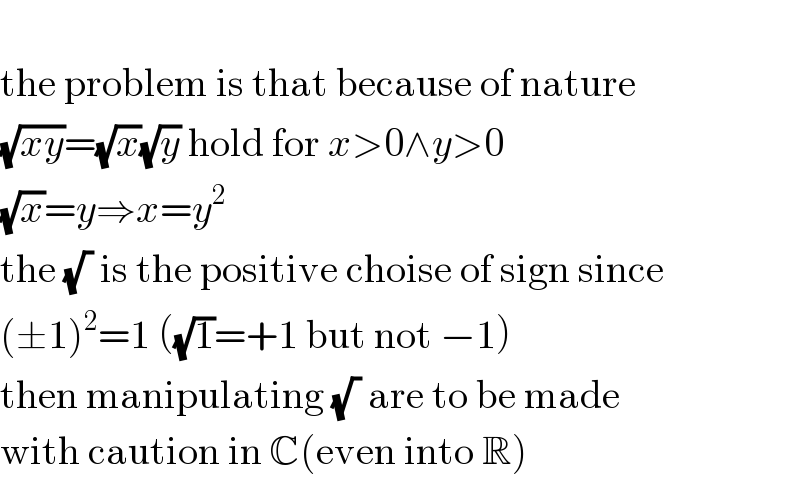
$$ \\ $$$$\mathrm{the}\:\mathrm{problem}\:\mathrm{is}\:\mathrm{that}\:\mathrm{because}\:\mathrm{of}\:\mathrm{nature} \\ $$$$\sqrt{{xy}}=\sqrt{{x}}\sqrt{{y}}\:\mathrm{hold}\:\mathrm{for}\:{x}>\mathrm{0}\wedge{y}>\mathrm{0} \\ $$$$\sqrt{{x}}={y}\Rightarrow{x}={y}^{\mathrm{2}} \\ $$$$\mathrm{the}\:\sqrt{\:}\:\mathrm{is}\:\mathrm{the}\:\mathrm{positive}\:\mathrm{choise}\:\mathrm{of}\:\mathrm{sign}\:\mathrm{since} \\ $$$$\left(\pm\mathrm{1}\right)^{\mathrm{2}} =\mathrm{1}\:\left(\sqrt{\mathrm{1}}=+\mathrm{1}\:\mathrm{but}\:\mathrm{not}\:−\mathrm{1}\right) \\ $$$$\mathrm{then}\:\mathrm{manipulating}\:\sqrt{\:}\:\mathrm{are}\:\mathrm{to}\:\mathrm{be}\:\mathrm{made} \\ $$$$\mathrm{with}\:\mathrm{caution}\:\mathrm{in}\:\mathbb{C}\left(\mathrm{even}\:\mathrm{into}\:\mathbb{R}\right) \\ $$
Commented by 123456 last updated on 17/Jul/15
![its a bit complex to talk about it, for exaple (√1)=±1 (√1)=(√(−1×−1))=(√(−1))×(√(−1))=±^1 i×±^2 i=±i^2 =±1 its much sensible to choose of branch multivariable functions are complex look that for z=x+yi e^z =e^(x+yi) =e^x (cos y+isin y) and remember that sin y=sin(y+2πk),k∈Z then for n∈N^∗ ln z=ln ∣z∣+(arg z+2πk)i z^(1/n) =e^((ln z)/n) =e^((ln ∣z∣)/n) e^((((arg z)/n)+((2π)/n)k)i) =^n (√(∣z∣))[cos (((arg z)/n)+((2π)/n)k)+isin (((arg z)/n)+((2π)/n)k)] where you can see that the branch choose is very importantuy with it you get n possible n roots to a number try to read some book ate multivariable valued function, it think it will help you. :)](Q1235.png)
$$\mathrm{its}\:\mathrm{a}\:\mathrm{bit}\:\mathrm{complex}\:\mathrm{to}\:\mathrm{talk}\:\mathrm{about}\:\mathrm{it},\:\mathrm{for}\:\mathrm{exaple} \\ $$$$\sqrt{\mathrm{1}}=\pm\mathrm{1} \\ $$$$\sqrt{\mathrm{1}}=\sqrt{−\mathrm{1}×−\mathrm{1}}=\sqrt{−\mathrm{1}}×\sqrt{−\mathrm{1}}=\overset{\mathrm{1}} {\pm}{i}×\overset{\mathrm{2}} {\pm}{i}=\pm{i}^{\mathrm{2}} =\pm\mathrm{1} \\ $$$$\mathrm{its}\:\mathrm{much}\:\mathrm{sensible}\:\mathrm{to}\:\mathrm{choose}\:\mathrm{of}\:\mathrm{branch} \\ $$$$\mathrm{multivariable}\:\mathrm{functions}\:\mathrm{are}\:\mathrm{complex} \\ $$$$\mathrm{look}\:\mathrm{that}\:\mathrm{for}\:{z}={x}+{yi} \\ $$$${e}^{{z}} ={e}^{{x}+{yi}} ={e}^{{x}} \left(\mathrm{cos}\:{y}+{i}\mathrm{sin}\:{y}\right) \\ $$$$\mathrm{and}\:\mathrm{remember}\:\mathrm{that}\:\mathrm{sin}\:{y}=\mathrm{sin}\left({y}+\mathrm{2}\pi{k}\right),{k}\in\mathbb{Z} \\ $$$$\mathrm{then}\:\mathrm{for}\:{n}\in\mathbb{N}^{\ast} \\ $$$$\mathrm{ln}\:{z}=\mathrm{ln}\:\mid{z}\mid+\left(\mathrm{arg}\:{z}+\mathrm{2}\pi{k}\right){i} \\ $$$${z}^{\frac{\mathrm{1}}{{n}}} ={e}^{\frac{\mathrm{ln}\:{z}}{{n}}} ={e}^{\frac{\mathrm{ln}\:\mid{z}\mid}{{n}}} {e}^{\left(\frac{\mathrm{arg}\:{z}}{{n}}+\frac{\mathrm{2}\pi}{{n}}{k}\right){i}} \\ $$$$\:\:\:\:\:\:=^{{n}} \sqrt{\mid{z}\mid}\left[\mathrm{cos}\:\left(\frac{\mathrm{arg}\:{z}}{{n}}+\frac{\mathrm{2}\pi}{{n}}{k}\right)+{i}\mathrm{sin}\:\left(\frac{\mathrm{arg}\:{z}}{{n}}+\frac{\mathrm{2}\pi}{{n}}{k}\right)\right] \\ $$$$\mathrm{where}\:\mathrm{you}\:\mathrm{can}\:\mathrm{see}\:\mathrm{that}\:\mathrm{the}\:\mathrm{branch}\:\mathrm{choose}\:\mathrm{is}\:\mathrm{very}\:\mathrm{importantuy} \\ $$$$\mathrm{with}\:\mathrm{it}\:\mathrm{you}\:\mathrm{get}\:{n}\:\mathrm{possible}\:{n}\:\mathrm{roots}\:\mathrm{to}\:\mathrm{a}\:\mathrm{number} \\ $$$$\left.\mathrm{try}\:\mathrm{to}\:\mathrm{read}\:\mathrm{some}\:\mathrm{book}\:\mathrm{ate}\:\mathrm{multivariable}\:\mathrm{valued}\:\mathrm{function},\:\mathrm{it}\:\mathrm{think}\:\mathrm{it}\:\mathrm{will}\:\mathrm{help}\:\mathrm{you}.\::\right) \\ $$
Commented by Rasheed Ahmad last updated on 17/Jul/15
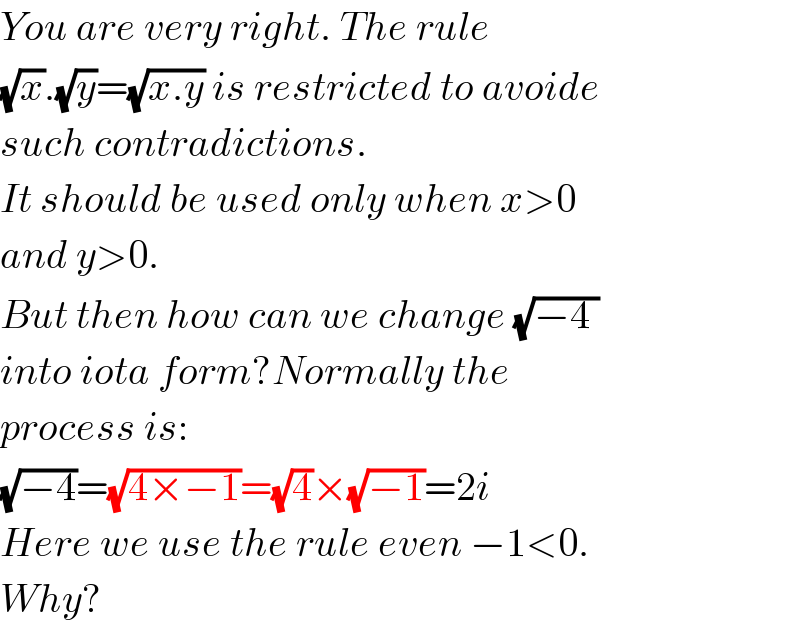
$${You}\:{are}\:{very}\:{right}.\:{The}\:{rule} \\ $$$$\sqrt{{x}}.\sqrt{{y}}=\sqrt{{x}.{y}}\:{is}\:{restricted}\:{to}\:{avoide} \\ $$$${such}\:{contradictions}. \\ $$$${It}\:{should}\:{be}\:{used}\:{only}\:{when}\:{x}>\mathrm{0} \\ $$$${and}\:{y}>\mathrm{0}. \\ $$$${But}\:{then}\:{how}\:{can}\:{we}\:{change}\:\sqrt{−\mathrm{4}\:} \\ $$$${into}\:{iota}\:{form}?{Normally}\:{the}\: \\ $$$${process}\:{is}: \\ $$$$\sqrt{−\mathrm{4}}=\sqrt{\mathrm{4}×−\mathrm{1}}=\sqrt{\mathrm{4}}×\sqrt{−\mathrm{1}}=\mathrm{2}{i} \\ $$$${Here}\:{we}\:{use}\:{the}\:{rule}\:{even}\:−\mathrm{1}<\mathrm{0}. \\ $$$${Why}? \\ $$
Commented by Rasheed Ahmad last updated on 17/Jul/15
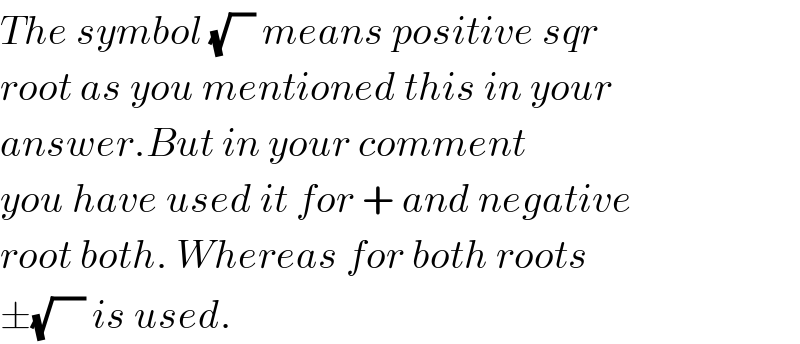
$${The}\:{symbol}\:\sqrt{\:\:\:}\:{means}\:{positive}\:{sqr} \\ $$$${root}\:{as}\:{you}\:{mentioned}\:{this}\:{in}\:{your} \\ $$$${answer}.{But}\:{in}\:{your}\:{comment}\: \\ $$$${you}\:{have}\:{used}\:{it}\:{for}\:+\:{and}\:{negative} \\ $$$${root}\:{both}.\:{Whereas}\:{for}\:{both}\:{roots} \\ $$$$\pm\sqrt{\:\:\:\:}\:{is}\:{used}. \\ $$
Answered by e.nolley@ieee.org last updated on 17/Jul/15
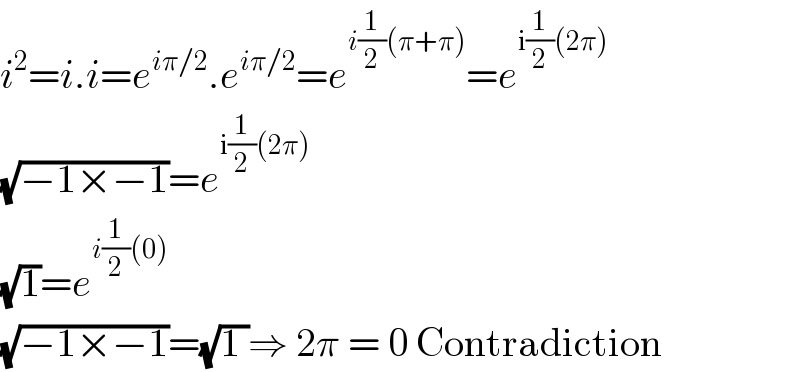
$${i}^{\mathrm{2}} ={i}.{i}={e}^{{i}\pi/\mathrm{2}} .{e}^{{i}\pi/\mathrm{2}} ={e}^{{i}\frac{\mathrm{1}}{\mathrm{2}}\left(\pi+\pi\right)} ={e}^{\mathrm{i}\frac{\mathrm{1}}{\mathrm{2}}\left(\mathrm{2}\pi\right)} \\ $$$$\sqrt{−\mathrm{1}×−\mathrm{1}}={e}^{\mathrm{i}\frac{\mathrm{1}}{\mathrm{2}}\left(\mathrm{2}\pi\right)} \\ $$$$\sqrt{\mathrm{1}}={e}^{{i}\frac{\mathrm{1}}{\mathrm{2}}\left(\mathrm{0}\right)} \\ $$$$\sqrt{−\mathrm{1}×−\mathrm{1}}=\sqrt{\mathrm{1}\:}\Rightarrow\:\mathrm{2}\pi\:=\:\mathrm{0}\:\mathrm{Contradiction} \\ $$
